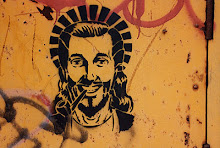 Happy Vernal Equinox! Today in the Northern Hemisphere, it's the first day of Spring, when the sun crosses the Celestial Equator and enters the sign of Aries.
Happy Vernal Equinox! Today in the Northern Hemisphere, it's the first day of Spring, when the sun crosses the Celestial Equator and enters the sign of Aries.It's a day for mourning the Goddess's consort, the Dying God, who has co-ruled with the Goddess during the autumn and winter months.
It is the first day of the year in the Zoroastrian calendar. It is the feast day of the Anglo-Saxon Goddess Easter, known to the Mesopatamians as Ishtar.
The Dying God is celebrated by an inscription in the Vatican, which says, "He who will not eat of my body, nor drink of my blood, so that he may be one with me and I with him, shall not be saved." No, that's not Jesus talking, but the God-Man Mithras, upon whose Temple ruins the Vatican was built. Mithras was a solar deity known as The Redeemer. His worship was before and concurrent with that of Jesus, but eventually faded away.
Mithras was Known as the "Good Shepherd" and the "Light of the World," just as was Jesus. Mithras's followers shared ritual communion meals of bread and wine. Mithras was born in a cave, of a virgin, on December 25th. Shepherds attended at his birth.
As the Burning Taper discussed some time ago, many God-Men were born on the Winter Solstice, and many died on the Vernal Solstice. Attis's mother was Cybele, a virgin, known as Queen of Heaven. Further back, we find the Babylonian Goddess Ishtar and her dying/resurrected son/lover Tammuz, born/resurrected at the Winter Solstice, dying at the Spring Equinox.
Even the name Easter comes from the word Ishtar.
The cross is an ancient symbol, pre-dating Christianity, often used to represent a solar deity. Inside a circle, the cross represents the Earth and her four seasons.
From "The Temple of Love: The History of the Temple of Ishtar":
In Her Temples in many lands from Egypt to Assyria to Babylon to Crete to India, in Rome and Greece and many Celtic lands, Her Temples had Sacred Priestesses who were also called Prostitutes by those of body denial religions. Her worship was in the arms of the Priestess who embodied and represented The Goddess(s). These worshipers are sometimes known as pagans.Happy Spring!
A fundamental difference in the concept of worship is important to note: In the Temples of the old ways people would go to the temple TO BE WORSHIPPED not to worship. Women would go to the temple to serve the Goddess to embody Her, to represent Her, to be worshipped as Her. Women would spend a day, or a week, or a year serving at the Temple as a priestess, as a sacred Prostitute, as a whore in service to the Goddess. There they would be worshipped as the incarnation of the Goddess, as The Goddess Herself.
Men would come to Her Temple TO BE WORSHIPPED. Men would be welcomed and served by the Priestesses and men would represent the divine male principal, the Horned One, the Sacred Bull, The God. Men would come to the temple to give their love and passion to The Goddess, and would receive the passion, love, and affection of The Goddess.
But some three millennia ago there came monotheists who refused Her Worship preferring instead to be diminished in body and spirit. They called Her, "The Whore of Babylon, who leads men into fornication." They called our sacred sexuality "sin," and cast shame on Her sacred Priestesses. They held up a "virgin" as the ideal that women should imitate instead of the sacred Goddess that they had always held as the most sacred image of Woman. This is essentially the state of things in the modern world.
The two principal deities of ancient Babylon were Baal and Ishtar. Baal was the god of war and the elements and Ishtar the goddess of fertility - both human and agricultural. These two deities have roots going back before Babylon to Nimrod at Babel and to Assyria. Through the ages they were imported into other nations and under different names but always retaining the same basic characteristics. Baal was also called Bel, Baalat, Molech, Merodach, Mars and Jupiter, and was frequently represented as a bull. Ishtar was also called Aphrodite, Astarte, Ashtoreth, Cybele or Sybil, Diana, Europa, Isis, Semiramis and Venus. The two main elements in the worship of Baal were fire and human sacrifice, usually children.
Sources:
Altreligion.About.Com
The Temple of Love: The History of the Temple of Ishtar
The Burning Taper: Let There Be Light
Born Jesus: Mother, behold thy Son! Son, behold thy Mother!
This article is reprinted from SacredFems.com.
Astrotheology | Ishtar | Baal | Cybele
Attis | Tammuz | Jesus | Virgin Mary

No comments:
Post a Comment